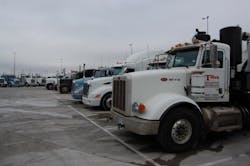Derek Leathers, president and COO of TL carrier Werner Enterprises, offered up the perfect summation of the freight markets this week at 2016 Stifel Transportation & Logistics Conference in Florida: “The freight environment is not robust right now, but certainly it’s not nearly as dismal as some of the commentary.”
Though I didn’t get a chance to attend Stifel’s 7th annual gathering, but John Larkin – managing director and head of transportation capital markets research at the firm – boiled down some of the key themes laid out by all the presentations and speeches.
Freight still stinks for most carriers, though he stressed that “stinks” is a technical term that can mean many different things to many different people. In his view, Larkin said the most pessimistic carriers referred to segments wherein freight had virtually evaporated., while others suggested that – after two “better than average” first quarters in 2014 and 2015 – freight still sits “about normal” for the first part of a typical year.In short, Larkin noted that those fleets with “exposure” to commodities, energy development, exports, and the industrial segment were “the most negative” while those with retail and/or automotive exposure were most positive.
The biggest “unknown factor” now affecting freight is the so-called “inventory glut” as many freight sectors remain burdened by excess inventories.
While Larkin stressed that overall inventory levels have been coming down slowly in recent months, much debate occurred during Stifel’s conference regarding how long it will take to draw down these surplus inventories across the board.
In his view, Larkin thinks that though freight demand probably won’t be robust once inventory levels reach what he calls “normalized levels,” it should feel somewhat better than it has for the past six to nine months.
“We should see some improvement, on the inventory front, in the second quarter as late spring/early summer merchandise is moved into place at stores, distribution centers, and fulfillment centers,” Larkin explained.
Yet there are other factors depressing freight these days, too, he emphasized, and they bear watching:
- Mediocre consumer spending, excluding the still strong automotive sector;
- Softening capital investment on the part of businesses;
- A seeming unwillingness to spend on the part of those benefiting from the decline in energy prices;
- A strong U.S. dollar, which depresses exports and stimulates imports;
- Weak energy exploration activities;
- The creation of mostly part time and/or low wage jobs.
On the flip side, Larkin pointed out that there are some “offsetting factors” that bode well for freight, too, especially the strength in the automotive sector, solid commercial construction activity, and population migration to business friendly states.
Yet casting a big shadow over all of those economic metrics is the rapid and long-expected approach of a regulatory tidal wave nears.
“As sand runs through the hourglass, bureaucrats are burning the midnight oil to publish as many business-inhibiting safety-related, fuel-efficiency related, and air quality rules and regulations – many to likely result in unintended consequences – as possible over the next 11 months or so,” Larkin said.His hope is that the next presidential administration will take a less urgent view with respect to the need for incremental rules and regulations on top of the mountain of already existing and often conflicting rules and regulations.
Here’s an interesting tidbit of analysis trucking companies might grind their teeth over: Freight brokers are the ones benefiting from currently “soft” supply/demand dynamic in Larkin’s estimation.
“Rates charged by carriers are dropping faster than are rates charged by brokers to their shipper customers,” he said.
In addition, enlightened, forward-thinking shippers are developing new and enhancing existing relationships with third party logistics providers (3PLs) in order to prepare for what Larkin has consistently described as the “mother of all capacity shortages.”
He expects that shortage to materialize by 2018 thanks to deteriorating driver demographics, the “onslaught” of federal regulations, and changing employment objectives in the part of many millennials.
As a result of all those factors, most carriers have suspended growth initiatives and are adopting what Larkin calls “a bunker mentality” by focusing on cost reductions and efficiency improvements during this period of soft freight demand.
“A few are taking advantage of their strong balance sheets and leverage with needy manufacturers to modestly increase the size of their fleets in preparation for the coming of more favorable freight conditions,” he said.That being said, at least for the near term, freight rates are definitely decelerating, with some shippers only offering modest, low single digit price increases to ensure that carriers will have sufficient incentive to provide desired capacity and service when supply and demand tighten.
“Some carriers said some shippers have demanded 5% or 10% rate reductions in order to avoid a re-bid,” Larkin noted. “Others claim that ‘inflation-plus pricing’ remains an achievable objective. Others suggest reality lies somewhere between these two extremes.”
A final note: Stifel also gives out a series of “awards” for “liveliest presentation” and things of that nature at its conference – an effort assuredly aimed at lightening the mood at a conference where presentations run almost non-stop from 7 am to past 5 pm.
Yet it it’s the back story to Werner’s Leather’s win for “best slide deck” that bears interest in terms of how trucking is adapting to changes in the freight environment.
Stifel feels that Werner’s “balanced strategy” that divides the company into three distinct segments – one-third truckload, one-third dedicated, and one-third asset-light logistics – is what’s helping the company deliver both “useful supply chain solutions” to customers as well as “less volatile financial performance” to its shareholders.
Something to think about as the industry forges ahead in uncertain times amid mixed freight indicators.






